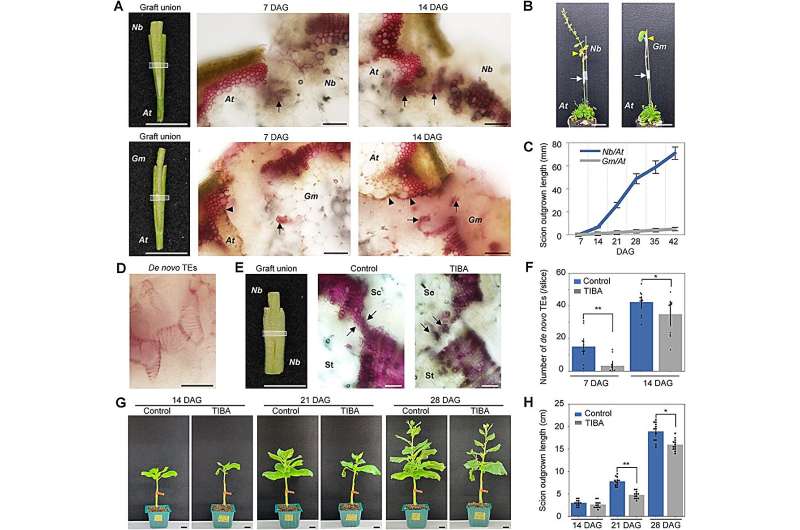This article has been reviewed according to Science X's editorial process and policies. Editors have highlighted the following attributes while ensuring the content's credibility:
fact-checked
peer-reviewed publication
trusted source
proofread
Elucidating xylem reconnection mechanisms in interfamily grafting: Molecular insights and implications

Grafting is a horticultural technique that has been utilized since ancient times to propagate ornamental and fruit trees, with its application extended to vegetable cultivation in recent decades. Central to its success is the graft union establishment, which relies on wound healing, cell adhesion, and vascular connection.
Generally, plants with close genetic relationships have a higher success rate in grafting, but recent studies have shown that species with distant genetic relationships also have grafting potential. This has given rise to interfamily partner accepting grafts (iPAG), which notably in the Nicotiana species, form xylem bridges similar to some parasitic plant-host combinations.
Tracheary elements (TEs), the primary components of xylem, play a critical role in transporting water and nutrients. However, there's still a challenge in establishing certain connections, like the phloem in Nicotiana iPAG. Therefore, the study of the molecular basis of xylem formation at the graft junction is essential for the achievement of interfamily grafting.
In April 2023, Horticulture Research published a research paper entitled "Nicotiana benthamiana XYLEM CYSTEINE PROTEASE genes facilitate tracheary element formation in interfamily grafting".
In this study, Nicotiana benthamiana grafted onto the inflorescence stem of Arabidopsis (Nb/At) as a successful interfamily graft combination, contrasting it with the incompatible Glycine max and Arabidopsis (Gm/At) graft. Observations around 14 days after grafting (DAG) showed xylem bridges forming between the scion and stock in the Nb/At graft, with scions and fruit setting, while not in Gm/At grafts.
Notably, TEs with spiral patterns was observed in Nb/At grafts. After inhibiting TE formation with 2,3,5-triiodobenzoic acid (TIBA), it was found that scion growth was also inhibited after 14 DAG. These results indicated that the growth of scions depends on the formation of de novo TE and the reconnection of xylem. In addition, the research investigated the molecular mechanism underpinning xylem formation during grafting by examining gene transcription.
VND1-VND7 are master transcription factors known to initiate xylem formation processes in Arabidopsis. The study determined that xylem formation began around 3 DAG, progressing with time. The expression patterns of genes related to xylem formation were then examined. Nb/At grafts showed increased expression of all four VND7 homologous genes in N. benthamiana, indicating their importance in xylem formation at the graft boundary. In contrast, Gm/At grafts displayed varying expression levels among VND7 homologous genes.
Further gene network analysis using the Weighted Gene Correlation Network Analysis (WGCNA) and Bayesian network analysis highlighted a core module of genes essential for xylem differentiation during grafting. One significant discovery was the NbXCP genes, which are crucial for forming de novo TE during grafting. GUS expression analysis was conducted in Nb/At and it was found that GUS expression was concentrated in the newly generated TE of callus at the graft.
The double knockout mutants of NbXCP1 and NbXCP2 produced using the CRISPR/Cas9 system showed cell digestion defects in differentiated stem TEs compared to the wild-type (WT). The survival rate decreased in the Nbxcp1;Nbxcp2/At grafts, while the NbXCP1-OX/At grafts tended to increase. Finally, the study also found that VND7 can bind to the NbXCP1 promoter, affecting its expression and thus affecting the formation of xylem.
In conclusion, this study elucidated the crucial role of xylem connections in successful interfamily grafting by exploring the molecular basis of xylem formation at the graft junction. Through transcriptome and gene network analyses, modules of genes responsible for TE formation, linked to xylem cell differentiation and immune response, were uncovered.
Notably, the functions of the Nicotiana benthamiana XYLEM CYSTEINE PROTEASE (NbXCP) genes in TE formation were validated, highlighting their role in enhancing the post-grafting growth rate and fruit size. These findings present significant implications for optimizing grafting techniques and enhancing plant resilience. Future investigations can delve deeper into the interplay between xylem formation and plant immunity, offering potential breakthroughs in grafting methodologies.
More information: Chaokun Huang et al, Nicotiana benthamiana XYLEM CYSTEINE PROTEASE genes facilitate tracheary element formation in interfamily grafting, Horticulture Research (2023). DOI: 10.1093/hr/uhad072
Journal information: Horticulture Research
Provided by NanJing Agricultural University

















